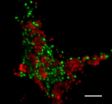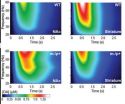(Press-News.org) Enjoying Spanish participation, an international group of researchers have analysed the most recent history of the Alhama de Murcia fault. They discovered that it has experienced six major earthquakes above 7 on the Richter scale. According to the scientists, this provides "convincing evidence" that the maximum earthquake magnitudes in the area are higher than originally thought.
Since 2001, researchers from the Universities of Barcelona, Leon, Complutense de Madrid (UCM), Coimbra (Portugal), Aahus (Denmark) and the National Autonomous University of Mexico have been working on the Alhama de Murcia fault in order to identify those high magnitude earthquakes that have occurred during the Quaternary period – the most recent of geological ages.
"Due to lack of information, up until just ten years ago there were no geological data on paleoseismic activity for the active faults in Spain and very little had been invested in studying their geology. The evidence used to understand active faults came merely from historical seismic records that hardly collected data on the largest of earthquakes related to these faults. As geology can go even further back in time, the earthquakes that we have found are bigger and of a greater magnitude," as explained to SINC by Jose J. Martínez Díaz, researcher at the UCM and coauthor of the study published in the journal 'Geological Society of America Bulletin'.
This fault is a fracture plane of the land that crosses the entire earth's crust. Therefore, to identify the prehistoric earthquakes in its walls, scientists had to make surface excavations perpendicular to the fault (trenches of between 20 and 30 metres long and 4 metres deep). This allowed for them to take an exceptionally extensive paleoseismic record.
As Martínez adds, "when large earthquakes exceed magnitude 6, they usually break at the surface and as a result, we have been able to identify this in their walls." These tectonic deformations were dated using carbon-14 and infrared stimulated luminescence techniques.
In order to understand the behavioural patterns of the Alhama de Murcia fault, the researchers had to reconstruct hundreds of thousands of years "much more than the Americans or the Japanese, who can understand their fault patterns by studying just 10 thousand years."
This is because faults in Spain are slow-moving and there is therefore much more time between major earthquakes (to the tune of thousands of years) compared to much faster-moving faults like San Andreas in California. According to their estimations, the Alhama fault would be created more than 9 million years ago and would have caused earthquakes from the outset thus shaping the landscape of the region.
"It was in our interest to detect the seismic activity from the Quaternary period, or, in other words, earthquakes that occurred more than 1.8 million years ago. In total, we have identified a minimum of six earthquakes of high magnitude during the period studied (more than 300,000 years) but we know that the real number is actually much higher. In some cases, sedimentary evidence could have disappeared or maybe they can be found in parts of the fault that have yet to be studied," outlines the researcher.
An underestimated seismic danger?
Another revelation according to the article is that the area could suffer from a stronger earthquake than originally thought. "During earthquakes, the entire length of the fault does not break. It does so in segments. We have proven that this fault could break at once at the two western segments, from Góñar (Almería) to Totana (Murcia) causing at the same time an earthquake of a magnitude above 7," explains Martínez.
"This fault has already produced an earthquake of magnitude 6.5 or 7 thousands of years ago, and could do so again tomorrow. As a result, it is vital to bear in mind the earthquake risk calculations and building codes on the area," outline the researchers.
The seismic hazard map forming the basis of the Spanish Seismic Resistance Construction Standard assigns the area of Lorca with a maximum acceleration for construction design of 0.19 g. However, the recent earthquake reached a magnitude of 5.2 and generated a much higher acceleration of 0.36 g.
"The area's hazard level was underestimated because until now estimations have been based on the historical earthquake catalogue which only records events from the last 2000 years," points out Martínez. The researcher believes that the fault activity parameters obtained through paleoseismic studies like this can help to improve risk calculations.
But will they be capable of predicting the next high magnitude movement? The authors stress that it is indeed possible to determine the maximum magnitude as well as the location of the earthquake. However, at present there is still no way of predicting the moment it will strike, as this involves a complex geological phenomenon governed by non-linear physical processes.
"Earthquakes like the one in Lorca and ones before produce fault stress changes which increase in certain points of the fault. We know this thanks to models and results that we have published from previous studies. The next earthquake is more likely to occur in these areas. However, estimating when is impossible," ensures the scientist.
With regards to the study recently published in the 'Nature Geoscience' journal that alludes to water extraction being the possible cause of the 2011 earthquake in Lorca, the researcher is doubtful.
"There is much scientific discussion on the matter, we are part of various groups that have been working in the area for some time and I am not the only one who is sceptic of the idea. The 2011 earthquake in Lorca was similar to those that took place in 1674 and 1818 at a time when aquifer exploitation was not practiced. I believe that there is no need to search for any unusual reason behind the earthquake. It was down to the fault's natural tectonic evolution. It was a completely normal earthquake from a geological point of view – the small magnitude kind which occurs on a fault every so often," concludes Martínez.
INFORMATION:
References:
María Ortuño, Eulalia Masana, Eduardo García-Meléndez, José Martínez-Díaz, Petra Štěpančíková, Pedro P. Cunha, Reza Sohbati, Carolina Canora, Jan-Pieter Buylaert, and Andrew S. Murray, "An exceptionally long paleoseismic record of a slow-moving fault: The Alhama de Murcia fault (Eastern Betic shear zone, Spain)", Geological Society of America Bulletin 1474 – 1494, septiembre –octubre de 2012.
At least 6 major earthquakes on the Alhama de Murcia fault in the last 300,000 years
2012-11-12
ELSE PRESS RELEASES FROM THIS DATE:
Scientists unravel the mystery of marine methane oxidation
2012-11-12
This press release is available in German.
Microbiologists and geochemists from the Max Planck Institute for Marine Microbiology, along with their colleagues from Vienna and Mainz, show that marine methane oxidation coupled to sulfate respiration can be performed by a single microorganism, a member of the ancient kingdom of the Archaea, and does not need to be carried out in collaboration with a bacterium, as previously thought. They published their discovery as an article in the renowned scientific journal Nature.
Vast amounts of methane are stored under the ocean ...
Obesity epidemic threatens health of all social groups equally
2012-11-12
It is often assumed that those on low incomes and with low levels of education are overly represented in the major increase in obesity of recent decades.
A new thesis from the Lund University School of Economics and Management, Sweden, shows that obesity is increasing across all social groups and that we need to look at factors other than socioeconomic status to understand and solve one of the major public health concerns of the Western world.
Åsa Ljungvall, a researcher in economics at the Lund University School of Economics and Management, has studied the increase ...
Smart drug improves survival in older patients with acute myeloid leukemia
2012-11-12
A new study has found Acute Myeloid Leukaemia (AML) patients given a new type of 'smart drug' in addition to chemotherapy treatment are 22 per cent less likely to relapse and around 13 per cent less likely to die from their disease. The results are from a major phase III Cancer Research UK-funded trial led by Cardiff University.
Of the 1,115 patients who took part in the trial, 68 per cent relapsed on the new treatment within three years, compared with 76 per cent of those who had the standard treatment. And 25 per cent were still alive after three years, compared with ...
Place in the sun carries risks for outdoor workers
2012-11-12
Those individuals who work outdoors with resultant sun exposure are at increased risk for non-melanoma skin cancers, such as squamous cell carcinoma and basal cell carcinoma. Manigé Fartasch shows that the connection between occupational UV exposure and squamous cell carcinoma is now well-established in her review article in issue 43 of Deutsches Ärzteblatt International (Dtsch Arztebl Int 2012; 109(43): 715−20).
The results are less clear for basal cell carcinoma, another form of non-melanoma skin cancer. Skin cancers caused by UV light have not yet been considered ...
The consequences of late preterm birth
2012-11-12
Delivery at any time before the 39th week of gestation increases the risk of postnatal problems and mortality. A team of authors headed by Christian F. Poets has analyzed mortality and morbidity data from epidemiological studies of infants born between two and six weeks preterm, comparing them with infants born at full term. They present their findings in issue 43 of Deutsches Ärzteblatt International (Dtsch Arztebl Int 2012; 109(43): 721−6).
As a rule, elective Cesarean sections are performed somewhat before full term, in order to prevent spontaneous delivery. However, ...
Ultrasound gel and infections: Researchers propose guidelines to reduce risk
2012-11-12
CHICAGO (November 12, 2012) – In the December issue of Infection Control and Hospital Epidemiology, the journal of the Society for Healthcare Epidemiology of America, guidelines have been proposed by epidemiologists from Beaumont Health System to reduce the risk of infection from contaminated gels. The recommendations are based on the authors' own experiences with an outbreak traced to contaminated ultrasound transmission gel.
In December 2011, researchers uncovered an unusual cluster of Pseudomonas aeruginosa in a cardiovascular surgery intensive care unit during routine ...
Study justifies L-DOPA therapy for Angelman syndrome
2012-11-12
CHAPEL HILL, N.C. – Last year a clinical trial of L-DOPA -- a mainstay of Parkinson's disease therapy -- was launched for Angelman syndrome, a rare intellectual disorder that shares similar motor symptoms such as tremors and difficulty with balance. The clinical trial is based on a 10-year-old case report showing benefit with the drug, but few studies since have explored the neurological justification for using L-DOPA to treat parkinsonian features in Angelman syndrome.
New research from the University of North Carolina School of Medicine, conducted in animal models ...
Patients shy away from asking healthcare workers to wash hands
2012-11-12
CHICAGO (November 12, 2012) – According to a new study published online today, most patients at risk for healthcare-associated infections (HAIs) agree that healthcare workers should be reminded to wash their hands, but little more than half would feel comfortable asking their physicians to wash. The study is published in the December issue of Infection Control and Hospital Epidemiology, the journal of the Society for Healthcare Epidemiology of America. The study points to the need for patient empowerment to improve hand hygiene of healthcare workers.
Researchers from ...
PI3-kinase and PARP inhibitor combo may offer new treatment option for triple-neg breast cancers
2012-11-12
PHILADELPHIA — The simultaneous inhibition of two separate and seemingly unrelated pathways could potentially provide an effective treatment for women with triple-negative breast cancer, according to results of two studies published in the November issue of Cancer Discovery, a journal of the American Association for Cancer Research.
Triple-negative breast cancers do not express three common targets of breast cancer treatments: the estrogen receptor, progesterone receptor and HER2/neu. As a result, women with triple-negative breast cancer have few treatment options. In ...
UNC, Vanderbilt discover a new live vaccine approach for SARS and novel coronaviruses
2012-11-12
Rapid mutation has long been considered a key to viral adaptation to environmental change. But in the case of the coronavirus responsible for deadly severe acute respiratory syndrome (SARS), collaborating researchers at the University of North Carolina and Vanderbilt University have found that accelerating the rate of mutations cripples the virus's ability to cause disease in animals. In addition, they say this finding may allow scientists to explore a new option for creating safer live vaccines.
A collaborative study, published Nov. 11 in Nature Medicine, demonstrates ...



